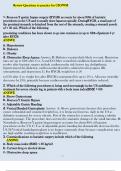Review Questions to practice for CSOWM
1. Roux-en-Y gastric bypass surgery (RYGB) accounts for about 80% of bariatric
procedures in the US and is usually done laparoscopically. DuringRYGB, a small part of
the proximal stomach is detached from the rest of the stomach, creating a stomach pouch
of < 30 mL. Which of the following
preexisting conditions has been shown to go into remission in up to 62% ofpatients 6 yr
after RYGB
ANSWE
a. Hypertension
b. Diabetes
c. Obesity
d. Obstructive Sleep Apnea: Answer: B: Diabetes is particularly likely to remit. Remission
rates are up to 62% after 6 yr. A and D: Other comorbid conditions thattend to abate or
resolve after bariatric surgery include cardiovascular risk factors (eg, dyslipidemia,
hypertension [A], diabetes), cardiovascular disorders, obstructivesleep apnea (D),
osteoarthritis, and depression. C: For RYGB, weight loss is 50
to 65% after 2 yr; weight loss after RYGB is maintained for up to 10 yr. All-cause mortality
decreases by 25%, primarily because cardiovascular and cancer mortalityis reduced.
2. Which of the following procedures is being used increasingly in the US asdefinitive
treatment for severe obesity (eg, in patients with a body mass index[BMI] > 60)
ANSWE
a. Sleeve Gastrectomy
b. Roux-en Y Gastric Bypass
c. Adjustable Gastric Banding
d. Vertical Banded Gastroplasty: Answer: A: Sleeve gastrectomy; because this procedure
causes substantial and sustained weight loss, it is being used increas- ingly in the US as
definitive treatment for severe obesity. Part of the stomach is removed, creating a tubular
stomach passage. The procedure does not involve anatomic changes to the small intestine. B:
Nonetheless, Roux-en-Y gastric bypasssurgery accounts for about 80% of bariatric
procedures in the US. C: Use of adjustable gastric banding has dramatically decreased in the
US. D: Vertical bandedgastroplasty is no longer commonly done because complication rates
are high andthe resulting weight loss is insufficient.
3. Contraindications to bariatric surgery include which of the following
ANSWE
a. Body mass index (BMI) < 30 kg/m2
b. Current drug or alcohol abuse
c. Obstructive sleep apnea
, Review Questions to practice for CSOWM
d. High-risk lipid profile: Answer: B: Current drug or alcohol abuse. A: The use of bariatric
surgery is controversial in patients with a BMI < 30. C and D: To qualify for bariatric surgery,
patients should have a BMI of > 40 or a BMI of > 35 plus a serious
, Review Questions to practice for CSOWM
complication (eg, diabetes, hypertension, obstructive sleep apnea [C], high-risk lipidprofile
[D]).
4. Bariatric Surgery Key Points: Consider weight loss surgery if patients are motivated,
have not succeeded using nonsurgical treatments, and have a BMI of
> 40 kg/m2 or a BMI of > 35 kg/m2 plus a serious complication (eg, diabetes, hypertension,
obstructive sleep apnea, high-risk lipid profile) or a BMI of 30 to 34.9with type 2 diabetes
and inadequate glycemic control despite optimal lifestyle and medical therapy.
Weight loss surgery is contraindicated if patients have an uncontrolled psychiatric disorder
(eg, major depression), drug or alcohol abuse, cancer that is not in remis-sion, or another
life-threatening disorder or if they cannot comply with nutritional requirements (including
life-long vitamin replacement when indicated).
The most common procedures are sleeve gastrectomy and Roux-en-Y gastric bypass; use of
adjustable gastric banding has decreased dramatically in the US.
Monitor patients regularly after surgery for maintenance of weight loss, resolution of weight-
related comorbid disorders, and complications of surgery (eg, nutritional de- ficiencies,
metabolic bone disease, gout, cholelithiasis, nephrolithiasis, depression,alcohol abuse).
5. Which of the following increases the risk of cardiovascular disorders inpatients with
obesity
ANSWE
a. Osteoporosis
b. Excess abdominal fat
c. Psychological disorders
d. Gastric Ulcer: Answer: B: Excess abdominal fat. Complications, including coro-nary
artery disease, are more likely in patients with fat that is concentrated abdom-inally. Choices
A, C, and D do not increase the risk of cardiovascular disorders in patients with obesity.
6. What is the role of ghrelin in food intake-regulating pathways
ANSWE
a. It increases food intake.
b. It decreases food intake.
c. Level decreases when weight is lost.
, Review Questions to practice for CSOWM
d. It integrates energy balance signals.: Answer: A: Ghrelin, secreted primarily bythe stomach,
increases food intake. B, C, and D: Other hormones and regulatory substances have these
effects.
7. Which type of exercise is MOST effective for increasing BMR
ANSWE
a. Aerobic exercise





